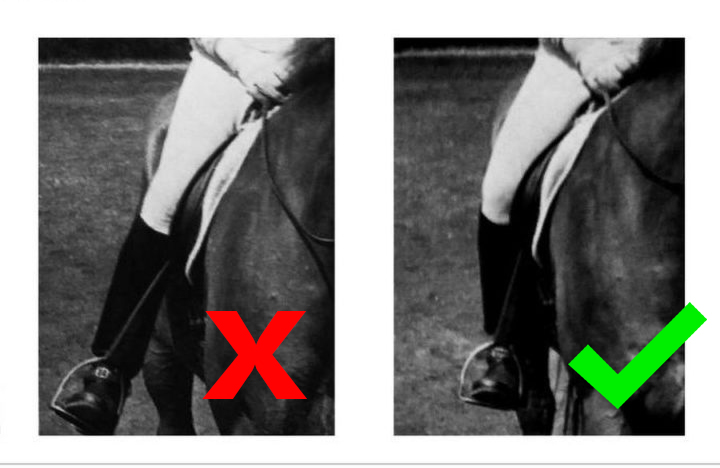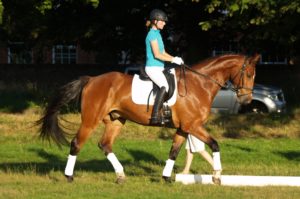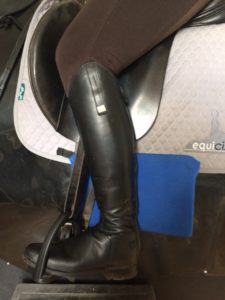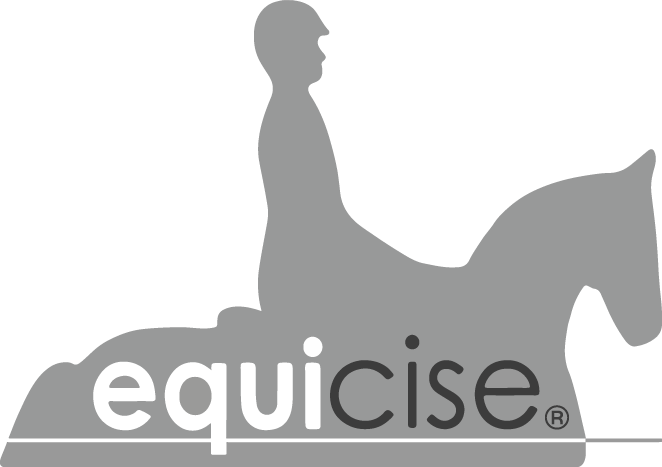16 Jun 5. Giving accurate leg aids

Once you have established an independent seat – strong core muscles, a stable frame and the ability to move each part of your body independently – you can start thinking more about what is needed to ensure you can give the most precise leg aids, with the correct degree of pressure in exactly the right place.
We have talked before about the need to remain relaxed as tension in any part of your body will prevent you from communicating as clearly as possible with your horse. And even once you have perfected your own position and achieved a balanced seat, it may take time for your horse to accommodate itself to your new way of riding – a horse that likes to please will, if you ride it regularly, have tried to understand what you are asking even if your aids have not been completely accurate or correct.
In order for your horse to learn what you expect from it, you will need to be consistent with your leg aids, both the position and pressure you apply – and, as with so much in riding, it may require some work from you to develop the necessary muscles to achieve the desired results, especially when asking for more advanced lateral movements.
 The application of leg aids will vary depending on the pace. In walk, you should be using each leg alternately, in alignment with the horse’s movement. In rising trot, you will be squeezing with both legs simultaneously each time you sit and releasing as you rise, so applying pressure only every other stride – you should make sure you keep a forward momentum in sync with the horse’s movement, so that you use your knees as a pivot, as if you were kneeling down and up rather than rising vertically, which would destabilise you. In sitting trot, however, you can encourage the horse forward with every stride, while in canter, a three-beat pace, you should be squeezing with both calves as the horse’s back rises and then releasing as its back flattens. In all paces, you should be following the movement of your horse.
The application of leg aids will vary depending on the pace. In walk, you should be using each leg alternately, in alignment with the horse’s movement. In rising trot, you will be squeezing with both legs simultaneously each time you sit and releasing as you rise, so applying pressure only every other stride – you should make sure you keep a forward momentum in sync with the horse’s movement, so that you use your knees as a pivot, as if you were kneeling down and up rather than rising vertically, which would destabilise you. In sitting trot, however, you can encourage the horse forward with every stride, while in canter, a three-beat pace, you should be squeezing with both calves as the horse’s back rises and then releasing as its back flattens. In all paces, you should be following the movement of your horse.
Since individual horses can react differently to the same leg aids, it may take time to recognise what is needed on any given occasion, but the fitter you are, the more likely you are to be able to apply the correct degree of pressure in the right place. The EQUICISE is an essential and effective training aid for developing clear and precise leg aids and building strength in the rider’s position. There are three leg sensors on either side of the EQUICISE’s torso and the screen in front of you gives feedback on exactly where your leg is placed, which you can also check by looking in the mirrors on either side. We so often think we are using our legs in the correct position when we are not — but you cannot fool the EQUICISE as it will only respond to your leg aids if they are in exactly the right place, whether you are asking it to move up or down through the paces or to perform lateral movements. You can also check on whether you are able to keep your hands still when you give a leg aid, thanks to the rein sensors. You can practise keeping your balance while applying leg aids in a variety of paces — why not challenge yourself in medium trot! A very effective way to build up strength in your legs is to switch off the leg sensors and practise applying leg aids with different degrees of pressure, either both at the same time or individually — something that you would obviously never subject a real horse to.
You can work on your leg aids for as long as you like in a way that would be impossible (and unkind) on a real horse, so book a LEG POSITION AND LEG AIDS LESSON to learn how to use your legs correctly and you will see the difference next time you ride
Practise this on the equicise simulator
 Use the ‘Instruction Ride’ setting. Press reset. With your left leg first practise finding sensors 1, 2 and 3 and then 3, 2 and 1. Then repeat with your right leg. Do the same exercise in walk, trot and canter using just one leg at a time. You will find it challenging performing this exercise accurately, but the more you engage your core, the more accurate and independent your leg aids will become. Next, using both legs, practise applying leg aids on sensor 2 on both sides at the same time, using your legs in an on off motion as if you were riding a real horse – you can even practise using a stronger leg aid, more of a kick, and making sure that as you do this, your body stays completely still (by checking the seat sensor) and that you still can use the leg accurately on the sensors. You can use pads tucked under the girth to give a more realistic feeling of the horse's sides.
Use the ‘Instruction Ride’ setting. Press reset. With your left leg first practise finding sensors 1, 2 and 3 and then 3, 2 and 1. Then repeat with your right leg. Do the same exercise in walk, trot and canter using just one leg at a time. You will find it challenging performing this exercise accurately, but the more you engage your core, the more accurate and independent your leg aids will become. Next, using both legs, practise applying leg aids on sensor 2 on both sides at the same time, using your legs in an on off motion as if you were riding a real horse – you can even practise using a stronger leg aid, more of a kick, and making sure that as you do this, your body stays completely still (by checking the seat sensor) and that you still can use the leg accurately on the sensors. You can use pads tucked under the girth to give a more realistic feeling of the horse's sides.




